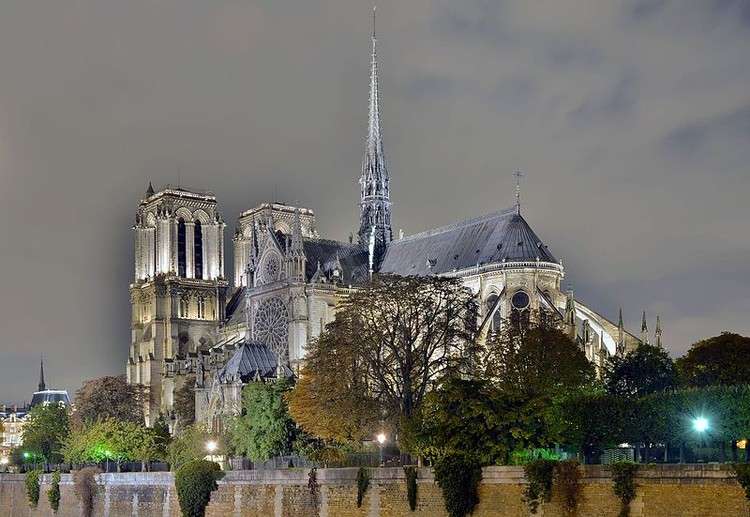
This article was originally published on CommonEdge as "Notre-Dame and the Questions It Raises About Sacred Space."
It was like watching someone die.
The most poignant images were the crowds of people in Paris kneeling in the streets, facing Notre-Dame with their heads down, praying for the cathedral as it smoldered. This was not just a demonstration of distress over a critical piece of France’s history going up in flames. Christians around the world observe the span of time between Palm Sunday and Easter Sunday as “Holy Week,” a period for believers more hallowed than Christmas. And a symbol of that faith was aflame, in the holiest seven days of the Christian calendar.

.jpg?1556105119)
For believers in Architecture with a capital A, it was as if the whole world was suddenly focused on your religion. You could turn on CNN and see an architectural historian talking about the finer points of Gothic architecture. People who didn’t know a finial from a flying buttress were tweeting about this tragedy, how it in some way brought them closer to other human beings. The destruction of a vital work of architecture more than 850 years old was actually doing this. Suddenly, it seemed as though architecture’s power over people was magnified, exalted. At least, that’s the way it might have appeared to those who worship at architecture’s altar.
For someone who reads and writes a lot about religious architecture, about the capacity of architecture to speak to spirituality, it seemed to me a double dose of heartache. Religious architecture is in a precarious state right now. Across all faiths, fewer people are visiting religious buildings. A Pew Research Center study released just last year focused on the “age gap” in religion around the world: fewer and fewer young adults (younger than 40) responded in the study that religion played an important role in their lives and that they attended religious services. The study found that this was the case in counties with different social and economic contexts, and also true in societies identified as more “religious” than secular. Pew and other research institutions have been monitoring how people self-identify their religious orientation, and the numbers have been trending this way for decades. You might have heard of the “Nones,” folks who check the “none” box on a survey form when asked what organized religion they identify with. Twenty-three percent across all age groups identify themselves as Nones in the U.S. today, more than the percentage of Roman Catholics. But oddly enough, a majority of Nones don’t describe themselves are atheists or agnostics. A Pew study in 2017 found that 72 percent of Nones say that they believe in God, a higher power, or a spiritual force. Another way to describe this majority among Nones is “spiritual but not religious.” A cathedral speaks to them about “sacred space” in different ways than it does to committed believers. But a burning cathedral can move them at a deeply human level.

A few years ago I worked with a studio of graduate architecture students to understand how they viewed spirituality in architecture. I asked them to define it for me. The majority didn’t talk about “smells and bells,” stained glass, or altars. Their focus was on what people did together in a space and whether it was spiritual or not. They didn’t believe architecture was sacred because someone had blessed it, or if it looked one way or another, or that it was made of a certain material. What seemed primary for these students was how the space allowed or encouraged people to relate to each other, how they shared with each other, how they cared for each other. So when these students were asked to design a sacred space, they focused on environments that would accommodate feeding the hungry, or making art together, or caring for children or the elderly, or communicating with others around the globe. For these students, the sacredness of a place resided in the possibilities of human interaction and meaningfulness, not in the fabric of the architecture itself. I learned a lot about the power of architecture from these students.
Notre-Dame will be rebuilt. It will, years from now, stand as it once did. Its new fabric will recreate what the cathedral looked like as contemporary people remember it (the architecture of Notre-Dame has changed quite a bit over its eight centuries). But will it fulfill the idea of a sacred space for the people who reconstruct it? They will be of a different time and place, and a reconstructed Notre-Dame will not speak to them as a sacred place as it did to those who raised it nearly a millennium ago.

The Trappist monk and mystic Thomas Merton warned against recreations of religious buildings; he saw them as denying the possibility that the sacred could be encountered in anything but a structure that looked like it had been built ages ago, “as if God did not belong to all ages and as if religion were really only a pleasant, necessary social formality, preserved from past times in order to give our society an air of respectability.” Merton believed that it’s up to every new generation to create architecture that speaks to the spirituality of its time, whatever it is.
Of course, Notre-Dame means different things to different people. People who are not religious or spiritual see it as part of the very material culture that makes France France, or as a landmark in the history of architecture and civilization. But as this cathedral’s reconstruction occupies our attention over the next decade or more, it’s worth asking questions about what sacred space means to us, if it means anything at all.

